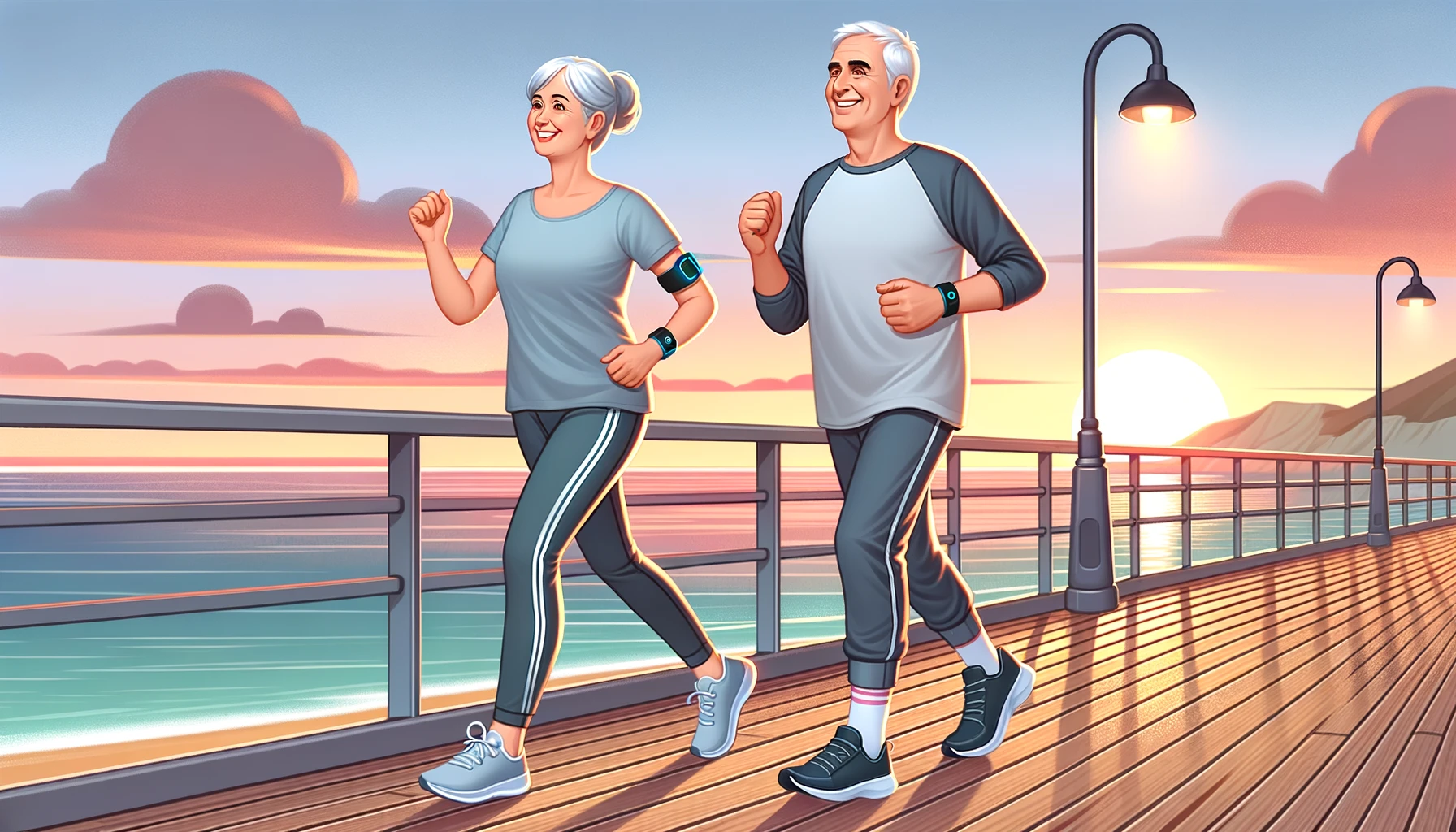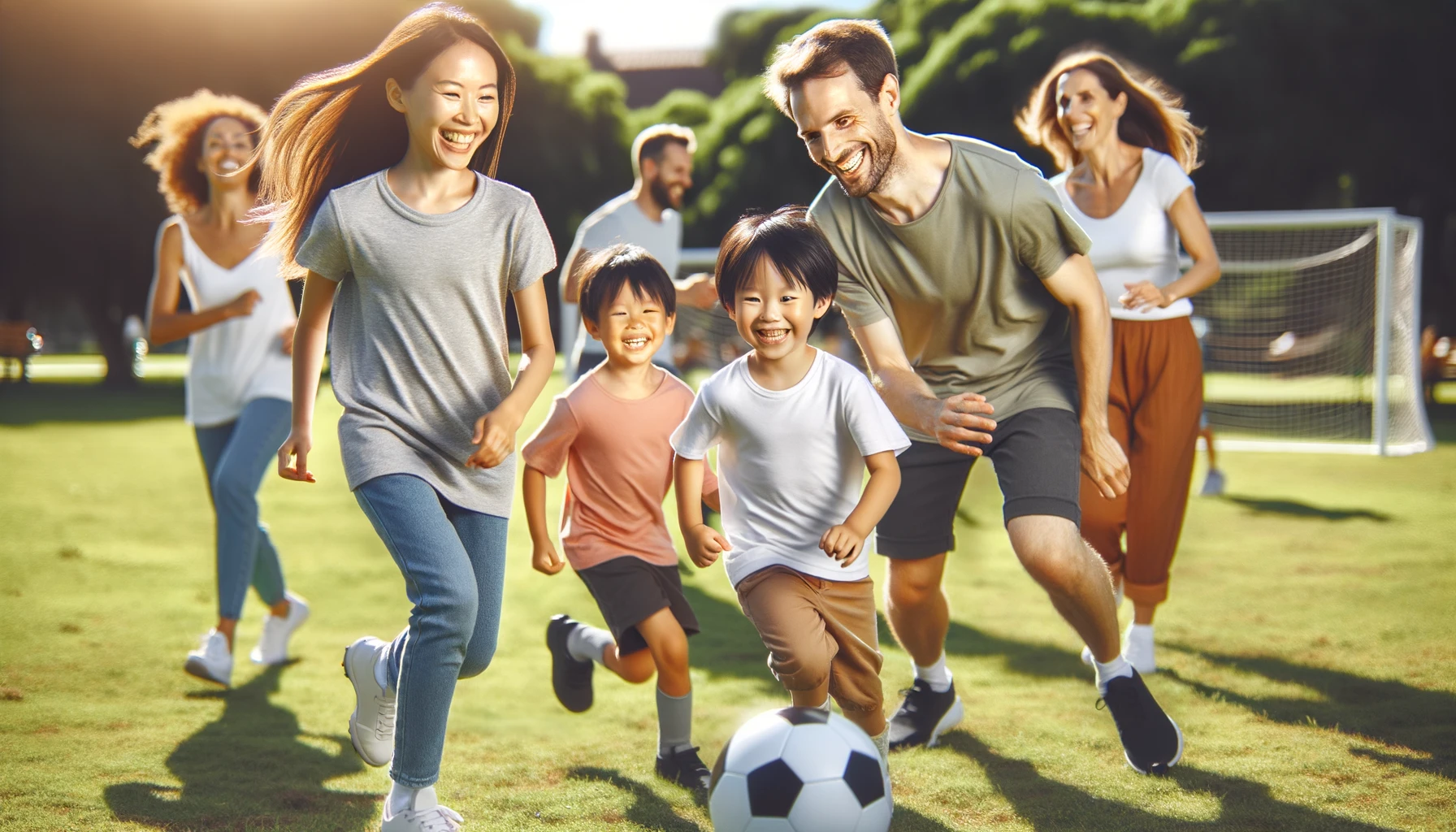As a passionate advocate for maintaining a healthy and active lifestyle, I am thrilled to bring you this article on physical activity for life. In today’s fast-paced world, it can be easy to overlook the importance of staying active and prioritizing our health. However, I believe that at any age, we have the power to make positive changes and embrace a life filled with vitality and well-being.
Physical activity for life is the key to unlocking a multitude of benefits. From boosting brain health to reducing the risk of chronic diseases, incorporating regular exercise into our routines should be a non-negotiable part of our daily lives. It not only helps us stay active but also empowers us to lead fulfilling and healthy lives.
So, regardless of whether you’re a child, an adult, or an older adult, it’s time to make physical activity a priority. Join me on this journey as we explore the amazing benefits of staying active and learn how to age gracefully, fostering a life filled with energy and joy. Let’s dive in and discover the incredible possibilities that physical activity offers at any age.

Benefits of Physical Activity for Adults
Engaging in regular physical activity provides a wide range of benefits for adults of all ages. From improving mental well-being to reducing the risk of chronic diseases, exercise plays a crucial role in maintaining overall health and vitality. Here are some key benefits of incorporating regular physical activity into your routine.
Improved Brain Health and Cognitive Function
Exercise has been shown to have a positive impact on brain health and cognitive function. Regular physical activity increases blood flow to the brain, which enhances mental clarity and boosts overall cognitive performance. Studies have also linked exercise to improved memory and increased focus and attention span.
Reduced Risk of Cardiovascular Disease
Engaging in regular exercise helps lower the risk of cardiovascular diseases like heart disease and stroke. Physical activity strengthens the heart muscle, improves circulation, and lowers blood pressure and cholesterol levels. These factors contribute to a healthier cardiovascular system, reducing the likelihood of developing heart-related conditions.
Prevention of Chronic Conditions
Regular exercise is a powerful tool in preventing chronic conditions such as type 2 diabetes and metabolic syndrome. Physical activity helps regulate blood sugar levels, improves insulin sensitivity, and aids in weight management. By incorporating regular exercise into your lifestyle, you can significantly reduce the risk of developing these conditions.
| Benefits of Physical Activity for Adults | |
|---|---|
| Improved brain health and cognitive function | Reduced risk of cardiovascular disease |
| Prevention of chronic conditions | Strengthening of bones and muscles |
| Enhanced daily functionality | Increased longevity |
Strengthening of Bones and Muscles
Regular physical activity plays a crucial role in maintaining strong bones and muscles. Weight-bearing exercises such as walking, jogging, and strength training help stimulate bone growth and increase bone density. Additionally, resistance exercises help build muscle strength, improving overall physical performance and reducing the risk of age-related muscle loss.
Enhanced Daily Functionality and Longevity
Engaging in regular exercise improves daily functionality and enhances quality of life. Physical activity helps maintain flexibility, balance, and coordination, making daily tasks easier and reducing the risk of falls and injuries. By staying active, you can also increase your longevity and enjoy a vibrant and fulfilling life well into your senior years.
Incorporating regular physical activity into your routine is essential for reaping these benefits. Whether it’s going for a brisk walk, participating in a fitness class, or engaging in sports, finding enjoyable ways to stay active is key. Remember, a little exercise goes a long way, and every step you take towards a healthier, more active lifestyle is a step towards a better quality of life.
Physical Activity for Older Adults
As we age, it becomes even more important to prioritize physical activity to maintain our health and well-being. Engaging in regular exercise can help older adults stay independent, prevent functional limitations, and reduce the risk of falls. Physical activity offers a wide range of benefits for older adults, from improving physical function to managing chronic conditions.
The Benefits of Physical Activity
Regular physical activity can significantly improve physical function in older adults. It strengthens bones and muscles, enhances balance and coordination, and promotes overall mobility. By staying active, older adults can maintain their independence and perform daily activities with ease.
Physical activity also plays a crucial role in managing chronic health conditions commonly experienced by older adults. For example, regular exercise can help reduce symptoms of arthritis by improving joint flexibility and reducing pain. It can also aid in managing type 2 diabetes by improving insulin sensitivity and supporting healthy blood sugar levels.

Age Well Through Physical Activity
Engaging in physical activity is not only about maintaining physical health but also about nurturing our overall well-being as we age. Exercise has been shown to boost mood, reduce feelings of anxiety and depression, and enhance cognitive function. By staying active, older adults can experience improved mental health and cognitive vitality, leading to a more fulfilling and active lifestyle.
To age well, it’s important for older adults to incorporate a variety of physical activities into their routine. This can include aerobic exercises like walking, swimming, or dancing, as well as strength and flexibility training. It’s always recommended to start at a comfortable level and gradually increase the intensity and duration of exercise.
| Benefits of Physical Activity for Older Adults |
|---|
| Improved physical function |
| Enhanced balance and coordination |
| Reduced risk of falls |
| Management of chronic conditions like arthritis and type 2 diabetes |
| Boosted mood and cognitive function |
| Promotion of overall well-being and active lifestyle |
By making physical activity a priority in our lives, we can age well and enjoy the benefits of improved physical and mental health. Whether it’s taking a brisk walk, joining a fitness class, or practicing tai chi, finding activities that we enjoy and that suit our abilities is essential. Let’s embrace the power of physical activity and prioritize our health and well-being as we grow older.
Physical Activity for Parents and Children
Physical activity is crucial for both parents and children to lead a healthy and active lifestyle. By engaging in regular physical activity, parents can set a positive example for their children and create healthy habits as a family. Additionally, physical activity offers numerous benefits for children’s growth, cognitive function, and emotional well-being.
As a parent, finding enjoyable ways to incorporate physical activity into your daily routine can be both fun and rewarding. Whether it’s going for a family walk or bike ride, playing outdoor games, or participating in sports activities together, the possibilities are endless. By prioritizing physical activity as a family, you not only promote overall health but also strengthen the bond between parents and children.
For children, regular physical activity is essential for their development and well-being. It helps improve their cardiovascular fitness, build strong muscles and bones, and maintain a healthy body weight. Physical activity also supports their cognitive function, allowing them to perform better in school and enhance their concentration and focus. Additionally, being physically active promotes socialization and teamwork skills through participation in group activities or sports.

Benefits of Physical Activity for Parents and Children
Physical activity provides a multitude of benefits for both parents and children. By staying active together, families can not only improve their physical health but also create lasting memories and strengthen their relationships.
| Benefits for Parents | Benefits for Children |
|---|---|
|
|
Incorporating physical activity into your family’s routine not only brings health benefits but also creates opportunities for quality time together. It allows parents to bond with their children, teaches important values like teamwork and perseverance, and encourages an active and healthy lifestyle from an early age. So, grab your running shoes, put on your favorite playlist, and embark on an exciting physical activity adventure with your children today!
Physical Activity During and After Pregnancy
Staying physically active during and after pregnancy is not only safe but also offers numerous benefits for both the mother and the baby. Regular exercise can help manage weight gain, reduce pregnancy discomfort, and improve overall well-being during pregnancy. It is important to choose appropriate activities and consult with a healthcare professional to ensure the safety and effectiveness of your exercise routine.
During pregnancy, low-impact exercises such as walking, swimming, and prenatal yoga can be gentle on the body while providing the necessary physical activity. These activities help strengthen muscles, improve circulation, and alleviate common pregnancy symptoms. It is recommended to aim for at least 150 minutes of moderate-intensity aerobic activity spread throughout the week.
After pregnancy, physical activity can aid in postpartum recovery, weight loss, and improving mood. Again, it is important to start gradually and listen to your body. Engaging in activities such as postnatal yoga, brisk walking with your baby in a stroller, or joining postpartum exercise classes can be beneficial. Be sure to prioritize self-care and seek support from healthcare professionals to create a safe and effective exercise plan.
| Physical Activity During Pregnancy | Physical Activity After Pregnancy | |
|---|---|---|
| Benefits | – Manages weight gain – Reduces pregnancy discomfort – Enhances overall well-being |
– Aids in postpartum recovery – Promotes weight loss – Improves mood |
| Recommendation | Aim for at least 150 minutes of moderate-intensity aerobic activity spread throughout the week | Start gradually and listen to your body |
| Activities | Walking, swimming, prenatal yoga | Postnatal yoga, brisk walking with a stroller, postpartum exercise classes |
Remember, every pregnancy is unique, and it’s essential to consult with your healthcare provider to determine the most suitable physical activity routine for your specific needs. By staying active during and after pregnancy, you can experience the benefits of physical activity while taking care of yourself and your baby.
Move Your Way: A Physical Activity Campaign
In an effort to promote the importance of physical activity and encourage individuals of all ages and abilities to lead a healthy lifestyle, the U.S. Department of Health and Human Services initiated the Move Your Way campaign. This campaign aims to raise awareness about the recommendations from the Physical Activity Guidelines for Americans and provides valuable tools, resources, and interactive guides for individuals, families, and health professionals.
The Move Your Way campaign emphasizes the need to find enjoyable ways to incorporate physical activity into daily life. It recognizes that everyone’s journey towards being more active looks different, and it encourages individuals to discover activities they enjoy. Whether it’s dancing, walking, gardening, or playing sports, the campaign highlights that there are countless ways to move your way towards a more active and healthy lifestyle.
The U.S. Department of Health and Human Services believes that physical activity should be accessible to everyone, regardless of age or abilities. The Move Your Way campaign serves as a powerful reminder that physical activity can be tailored to fit individual needs and preferences. By participating in regular physical activity, individuals can experience the numerous health benefits it offers, such as improved mental well-being, reduced risk of chronic diseases, and enhanced overall quality of life.
Join the Move Your Way campaign today and discover the joy and benefits of being active. Visit the campaign’s website to access valuable resources, including personalized activity plans, activity trackers, and tips on how to incorporate physical activity into daily routines. Remember, moving your way towards a healthier future starts with a single step!

Keeping Active Safely and Effectively
When it comes to physical activity, safety should always be a top priority. By following some simple guidelines, you can ensure that your workouts are both effective and injury-free. It’s important to start gradually and choose activities that are suitable for your fitness level and abilities. This will help prevent overexertion and reduce the risk of strains or sprains.
Before engaging in any physical activity, it’s crucial to warm up your muscles and stretch properly. This helps prepare your body for exercise and reduces the chance of injury. Taking a few minutes to loosen up your joints and muscles can make a significant difference in preventing strains and improving overall flexibility.
Listening to your body is key to staying safe during physical activity. Pay attention to any signs of fatigue, discomfort, or pain. Pushing through these warning signs can lead to injury. Take breaks when needed, stay hydrated, and don’t hesitate to modify your activities if necessary. Remember, it’s always better to be cautious and make adjustments rather than risk injury.
“Safety is not an accident. It’s a choice we make every time we engage in physical activity. By prioritizing our well-being and following proper guidelines, we can enjoy the benefits of exercise while minimizing the risk of injury.”
If you’re unsure about which exercises are best for you or how to properly perform certain movements, it’s always a good idea to consult with a healthcare professional or certified fitness instructor. They can provide personalized guidance based on your specific needs and goals, ensuring that your physical activity routine is both safe and effective.
| Safe Physical Activity Tips | Effective Physical Activity Tips |
|---|---|
|
|
Conclusion
Physical activity is the cornerstone of a healthy lifestyle, providing a myriad of benefits for people of all ages. From improving mental well-being to reducing the risk of chronic diseases, staying active is essential to maintaining overall health and well-being. By incorporating regular physical activity into our lives, we can enhance our quality of life and lead fulfilling, active lifestyles.
Engaging in physical activity offers immediate and long-term benefits for adults. It improves brain health, reduces anxiety, and enhances cognitive function. Regular exercise also helps manage weight, lowers the risk of cardiovascular diseases, and prevents chronic conditions such as type 2 diabetes and metabolic syndrome. Additionally, physical activity strengthens bones and muscles, improves daily functionality, and increases longevity.
For older adults, staying active is crucial for maintaining independence, preventing functional limitations, and reducing the risk of falls. Engaging in physical activity improves physical function, strengthens bones and muscles, and enhances balance and coordination. It also plays a vital role in managing chronic health conditions, such as arthritis and type 2 diabetes. By incorporating regular physical activity, older adults can age well and enjoy a fulfilling and active lifestyle.
Physical activity is equally important for parents and children. Encouraging children to be active for at least 60 minutes a day promotes their overall health and development. Parents can set a positive example by engaging in physical activities with their children, creating healthy habits as a family. Regular physical activity aids in children’s growth, cognitive function, and emotional well-being while helping parents stay active and fulfill their role as primary caregivers.
During and after pregnancy, physical activity offers numerous benefits for both mothers and babies. Staying active during pregnancy can help manage weight gain, reduce discomfort, and enhance overall well-being. Engaging in physical activity after pregnancy assists in postpartum recovery, weight loss, and improving mood. It is vital to choose appropriate activities and consult with healthcare professionals to ensure the safety and effectiveness of the exercise routine.
The Move Your Way campaign, initiated by the U.S. Department of Health and Human Services, aims to promote the recommendations from the Physical Activity Guidelines for Americans. It encourages individuals, families, and health professionals to find enjoyable ways to incorporate physical activity into daily life. Regardless of age or abilities, everyone can experience the health benefits of being physically active.
To engage in physical activity safely and effectively, it is crucial to start gradually and choose activities suitable for your fitness level. Warming up and stretching before exercise helps prevent injuries, and staying hydrated is essential. Proper equipment or protective gear should be used when necessary. Seeking guidance from healthcare professionals or certified fitness instructors can provide personalized advice for safe physical activity.
In conclusion, physical activity should be an integral part of a healthy lifestyle at any age. By embracing regular exercise, we can enhance our overall health, maintain functional independence, and improve our quality of life. Let’s choose activities we enjoy, start at a comfortable level, and seek guidance from professionals to ensure safe and effective physical activity.
FAQ
What are the benefits of regular physical activity for adults?
Regular physical activity can improve brain health, reduce anxiety, manage weight, lower the risk of cardiovascular diseases, prevent type 2 diabetes and metabolic syndrome, strengthen bones and muscles, improve daily functionality, and increase longevity.
How can older adults benefit from engaging in physical activity?
Older adults can benefit from physical activity by maintaining independence, preventing functional limitations and falls, improving physical function, strengthening bones and muscles, enhancing balance and coordination, and managing chronic health conditions such as arthritis and type 2 diabetes.
How does physical activity benefit parents and children?
Physical activity promotes overall health and development in children, aiding in growth, cognitive function, and emotional well-being. Parents can set a positive example and create healthy habits by engaging in physical activities together. It also helps parents stay active and supports their role as primary caregivers.
What are the benefits of physical activity during and after pregnancy?
Staying active during pregnancy can help manage weight gain, reduce pregnancy discomfort, and enhance overall well-being. Engaging in physical activity after pregnancy can assist in postpartum recovery, weight loss, and improving mood.
What is the Move Your Way campaign about?
The Move Your Way campaign, initiated by the U.S. Department of Health and Human Services, aims to promote the recommendations from the Physical Activity Guidelines for Americans. It provides tools, resources, and interactive guides for individuals, families, and health professionals, emphasizing the importance of finding enjoyable ways to incorporate physical activity into daily life.
How can physical activity be performed safely and effectively?
To engage in physical activity safely, it is important to start gradually, choose activities suitable for your fitness level and abilities, warm up and stretch before exercise, listen to your body, stay hydrated, and use proper equipment or protective gear when necessary. Consulting with a healthcare professional or certified fitness instructor can provide personalized guidance.
Why is physical activity important for a healthy lifestyle?
Physical activity offers numerous benefits, including improving mental well-being, reducing the risk of chronic diseases, maintaining functional independence, and improving overall quality of life.
